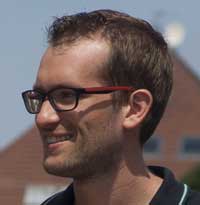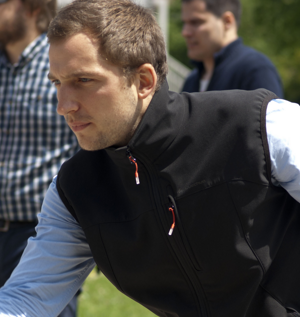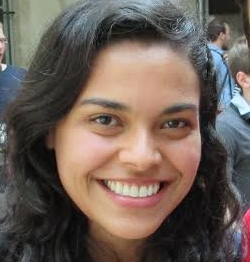
Ecological impacts of urban forms. Urban and landscape modelling 
The global increase of urbanization during the past decades have induced a progressive artificialization of natural environments. The building of transport infrastructures and new housings causes a landscape fragmentation in an irreversible way and a strong decrease of the connectivity of ecological habitats. Maintaining the functionality of ecological networks is becoming a major goal of sustainable urban planning policies. With a special focus on urban evolutions in the horizon 2030 in the urban area of Besançon in eastern France (residential development and road traffic evolutions), this thesis aims to assess the potential impact of urban forms on landscape connectivity of animal species’ ecological networks. This research work promotes a modelling approach both on the field of theoretical and quantitative geography and landscape ecology. This approach follows three main steps: (1) simulating residential development and its associated road traffic changes using five prospective scenarios of differentiated urban forms (MobiSim); (2) modelling landscape graphs of various animal species using land-cover maps and ecological data; (3) assessing the potential impacts of each scenario on ecological networks from these graphs using connectivity metrics, with measures of the connectivity decrease attributable to each residential development scenario. Contrary to sprawled cities, the results show that compact and dense urban forms best promote the maintenance of ecological connectivity for the majority of species groups. Further analysis highlights the great contribution of road traffic evolutions regarding the ecological impacts of each scenario. According to some sensitivity analysis, the model used is quite robust. It demonstrates the interest of modelling in the decision-making process for environmental conservation and urban planning to think out the city of tomorrow in a sustainable way.
The manuscript in French can be downloaded from: https://tel.archives-ouvertes.fr/tel-01299060v1


Exploration of future changes of residential locations in an urban agglomeration using MobiSim
Joanne Hirtzel
Suitable housing supply represents a major planning concern. It depends on households’ characteristics and lifecycle changes (union, birth, divorce, etc.). Residential choice factors are numerous (housing and residential environment characteristics) and their role is often different according to types of households. Residential dynamics involve a great variety of interacting elements and the causal relationships are difficult to identify. MobiSim is used to study urban residential dynamics and to analyse new residential location of moving households. The model is based on demographic microsimulation that allows reproducing households lifecycle within the dynamic agent-based MobiSim platform. A part of the thesis is dedicated to the calibration of both models, a required stage preliminary to scenarios simulation. Another part of the thesis concerns the exploration of residential behaviours, in order to assess the simulation results’ stability and their consistency (sensitivity analysis). A specific protocol has been designed. It takes into consideration the parameters characteristics, simulation technical constraints, and the initial design for which MobiSim has been built.The last part of the thesis consists of thematic analyses aimed at studying the impact of two housing construction planning scenarios in the urban region of Besançon. These analyses highlight the ability of MobiSim to answer concrete planning questions and to initiate discussion in urban planning contexts.
The manuscript in French can be downloaded from: https://hal.archives-ouvertes.fr/tel-01121665v2

COSMELUX: COunter urban Sprawl in the MEtropolitan area of LUXembourg
Within the case of Luxembourg, both residents of the country and cross-border workers are faced to car dependency. In this context, the main goal of the thesis is to shed some light on residential growth patterns and daily mobility which comes up with. In order to do so, a two step methodology is applied: (1) the simulation of residential growth for the whole country of Luxembourg in 2030, through several scenarios (fractal, TOD, Inner City) and (2) the comparison of these different spatial configurations in terms of accessibility to urban and green amenities, but also in terms of daily mobility related to the new urban developments. The MobiSim platform is being used to simulate daily mobility for all residents in Luxembourg and cross-border workers who access by car. The simulation occurs in 2010 and for each scenario in 2030. Some improvements have been made to the MobiSim model which is now able to deal with new schedules for all agents (work, studies, shopping, leisure, social relations, and child accompaniment). Cross-border workers were also included into the traffic, which was necessary to the Luxembourgish case.
Thesis funded by the National Research Fund of Luxembourg.
The manuscript in French can be downloaded from: https://hal.archives-ouvertes.fr/tel-01237069

“Heavy buildings” and urban renewal: agent-based simulation and sustainability assessment
This PhD research proposes to address the issue of urban sprawl through the development of a scenario of compact urban renewal. This scenario is based on the reuse of what we call « heavy buildings », i.e buildings which are prominent by their form and difficult to modify by their social significance. In the case of Besançon, the case study of the PhD, these buildings are composed of a set of fortified and military areas located in the center and in fringe-belts, that could be reinstated as spaces for urban renewal to limit the impacts of urban sprawl. In this context, MobiSim is used to assess the consequences of such an reuse at the horizon 2030. A first step consists in the implementation of the scenario into the MobiSim platform. To achieve the objectives of the study, some simulations are carried out through an iterative process. In a second step, the research combines the outputs of the model by cross indicators, which allow assessing the impact of the the simulation results on the three spheres of sustainable development.
The manuscript in French can be downloaded from: https://tel.archives-ouvertes.fr/tel-01293610v1
Transport and land use policies assessment: proposition for an offset decision-making indicator
The objective of this PhD research is to seat MobiSim and its role in urban planning processes by focusing on the comparative assessment of the scenarios (land use and transport) simulated within the model. It is based on the postulate that the combination of MobiSim social, economic and environmental results can concretely impact the choice of a planning policy or another. Indeed, the founding assumption, untested to our knowledge, is that a sustainable policy should be a compromise between the three spheres whose stakes are antithetical compromise for which "offset indicators" can help decision making. To achieve this goal, a first step consists in defining a methodology to standardize the numerous outputs of the model, within a single platform allowing to visualize and to interpret a set of results together and from different viewpoints. Secondly, the project tries to combine these results in a synthetic indicator, which will be propounded to planning actors and stakeholders as a complementary tool for decision-making.
Cellular automata calibration for residential development simulation
Various studies highlight the usefulness of simulation tools in research focusing on land use change. Among simulation tools, Cellular Automata (CA) are well adapted with their geometric properties and potential to identify emerging spatial structures and processes. The transition rules definition is a key step of these CA-based simulations. Indeed, “in the context of urban systems, we often have no idea what the “right” rules are”. In our approach “right rules” should be thematically interpretable rules reproducing observed changes. This PhD tackles the issue of CA rules creation and proposes to use Decision Tree (DT) to automatically design and calibrate them. Each cell is characterized by variables representing its neighbourhood and geographical location features. The main focus is on cells that underwent a transition from a non-urban to an urban land use in order to address the urban development issue. Results obtained using the DT help to create a set of transition rules based on information about the type of neighbourhoods that lead to urban transitions. The efficiency of the DT transition rules sets is evaluated comparing observed land use cover evolution from CorineLandCover database and CA based simulated data. LucSim CA developed from scratch in ThéMA is used to simulated rule sets produced out of the DT process. Simulations provide an urban development base map that can be use within the MobiSim software application.
![]()
Conceptualization, modelling and evaluation of the implementation of a typology of vertical eco-district for sustainable urban planning
Jean Houssemand
The aim of thesis is to evaluate the consequences of a prospective scenario of urban renewal, at the scale of Strasbourg’s urban areaby 2030, based on the substitution of a vertical eco-district model to the classic urban model of city centers with their collective residential buildings. That evaluation is made through comparison with a "business as usual" scenario initiated on a similar temporal and geographical scale, using the MobiSim LUTI simulation platform. The aim is to evaluate and quantify the pertinence and interest of such an alternative in an urban area where, in terms of housing, there is a profound divide between periurban spread (dominated by the model of individual housing) and urban renewal or dense development (characterised in particular by the model of collective residential buildings). When it comes to habitat, the segregation between periurban spread – notably through the model / paradigm of individual housing – on the one hand, and dense urban renewal and development – notably through the typology of collective dwelling buildings – on the other hand, is important.The main objectives are as follows: 1) describe the phenomenon of periurbanization of housing, identify the costs of such urban spread and provide a possible answer through the hypothesis of vertical eco-districts in city-centers; 2) at the scale of the compact city, evaluate the implantation potential of those tridimensional structures, with a view both to reconversion of useless existing buildings and to new urbanization; 3) implement a prospective modeling so as to evaluate the impacts on the territory, the urban shape and the daily and residential mobility (MobiSim platform); 4) analyze the results, notabl regarding sustainability objectives.

Influences of stakeholders' strategies on the spatial configurations of daily mobility: an exploration through simulation
In French medium-size urban areas, until the 80s, daily frequented places of activity were spatially concentrated. The increasing use of motorized individual transport modes has favored the spatial dispersion of activity places. This new organization has a high individual utility but alters the collective interest (pollution, congestion...). Faced to this situation, public stakeholders attempt to reduce the negative effects for the local community that result from individual motorized mobility behaviors. Actions and strategies implemented by public stakeholders sometimes allow them to reach this objective but, in some cases, they just shift the problems (e.g. local congestion is transferred from one place to another one) or even create unexpected negative effects (e.g. planning actionsto limit car use in city centers may cause individuals to visit shops located in the outskirtsof cities, thus increasing the total distance traveled by car by all inhabitants). The doctoral research aims at studying the issues of stakeholders' strategies and actions on individual mobility behaviors and their effects, at the level of a local community. To this end, the agent-based LUTI simulation platform MobiSim is used to simulate individual mobility behaviors resulting from a series of scenarios representing various strategies and actions of stakeholders.

MobiSim application in Rio de Janeiro (Brazil)
In Brazil, the recent economic development, and the gradual increase in living standards have had a significant impact on urban mobility, particularly with regard to access to private vehicles. Currently Rio de Janeiro - Brazil's second financial center, and one of the most visited cities by tourists from all around the world - is experiencing episodes of strong congestion, due to the saturation of the main roads, and an offer of public transportation that is fragmented and inefficient. In this context, this research aims to provide scientific support for urban planning actions and public policies in order to better lead the evolution of the transport system of the Greater Rio de Janeiro. The application of MobiSim to the Brazilian reality is an important instrument to ensure that the growth of the city will not be limited by its transport system.





